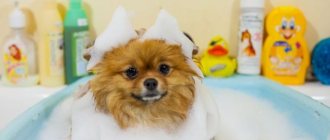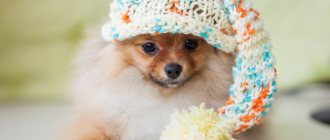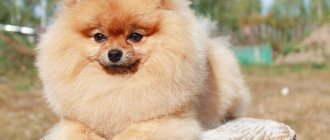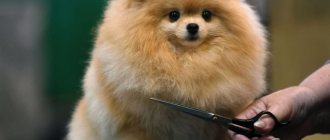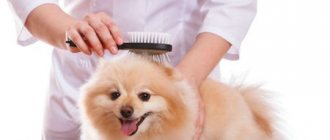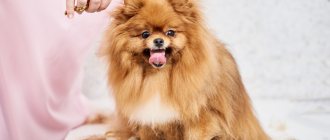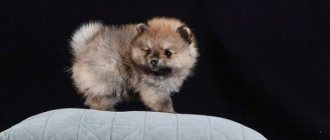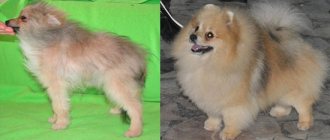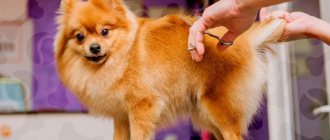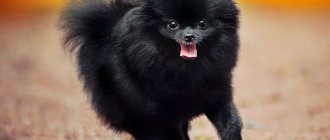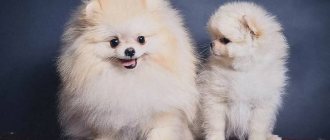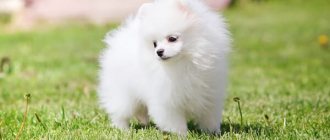Spitz is a breed of dog with thick long hair, which is their decoration and a source of pride. Caring for it is not particularly difficult, but it does take time.
To ensure that your pet always healthy and well-groomed, you need to bathe it regularly , comb it at least twice a week cut it from time to time .
Features of hair care
Orange fur is one of the main advantages of the breed. It is long, especially around the neck, where a real “lion’s mane” grows, airy, with a very thick undercoat, easily tangled and matted. Spitz have an arctic type of coat (protects from heat in summer and from cold in winter), so complete removal of hair spoils its structure, the hairs grow thin, weak, and fall off faster. The basic principles for caring for the skin are regularity and plenty of time. Then your Pomeranian will always look healthy and well-groomed.
Diseases and treatment
Pomeranians, like all artificially bred breeds, are prone to certain diseases.
- Dental problems. It is necessary to constantly examine the dog’s teeth yourself and, in case of any deviations, show the animal to a veterinarian-dentist.
- Cough. Occurs due to the special structure of the larynx, as a result of physical activity. This is not dangerous, the cough goes away when the dog calms down.
- Eye problems - excessive tearing from heat, dust, wind. Occurs due to anatomical features, symptoms are relieved with special drops.
- Problems with the thyroid gland - hypothyroidism. Symptoms of this disease are: hair loss, obesity, dermatitis.
- Genetic disease - congenital dwarfism.
- Problems with bones and joints . It can be treated with medication, and you should also ensure that the dog does not jump from high places.
Basic procedures
Grooming consists of combing, washing and cutting; Each procedure has its own frequency and characteristics. After each manipulation of the fur, reward the dog with a treat, especially if it behaved well.
Photo: wikimedia.org
Combing
Regularity: once a week - for a short-haired dog, twice a week - if the Spitz is uncut. Rain while walking is a reason for extra brushing.
Means: combs with teeth of different frequencies, massage brushes - do not damage the hair and do not cause pain to the dog; conditioner and spray - make combing easier and improve appearance. Select the frequency of the teeth so that it does not allow tangles to pass through, but also does not pull out hairs. Do not use powder brushes: they injure the skin and cause inflammation.
Procedure: carried out at home, on a table, the dog should lie on its side; For the first time, you can brush the puppy on your lap. Mats often form in the groin, under the jaw, near the front legs and behind the ears. Pay attention to these places first. You need to brush in the direction from the tail to the head, against the growth of the hair - this way the skin is better aerated (especially important for wet wool). At the end, fluff the fur with your fingers - this way it will remain fluffy and stuffed longer. If your dog has problem hair, you have neglected it, cut the mats yourself. If you will be participating in an exhibition in the near future, it is better to contact a professional groomer: perhaps he will be able to untangle the tangles with the help of anti-tangle products.
If you have aggression when scratching, watch this video.
Bathing
Regularity: once every 1-2 months and outside the schedule before the exhibition.
Products: Use dog cosmetics for washing. Human (even expensive and well-known) shampoos are not suitable for this purpose.
How to choose dog cosmetics:
- one brand for shampoo, antistatic agent and conditioner,
- hypoallergenic,
- special bleaches - to whiten the areas under the eyes of white Spitz dogs,
- powdered, dry shampoos for animals that do not like to bathe.
Procedure: carefully plug the dog's ears with cotton swabs to prevent water from getting into them, dilute the shampoo and conditioner separately with water, wet the skin well with warm water, distribute the shampoo, lather, rinse. Treat the washed fur with conditioner and rinse. Wash your Pomeranian only after brushing.
Drying
Regularity: Be sure to dry the fur after each bath. Deep in the orange skin, which remains wet for a long time, an environment favorable for bacteria and fungi is created.
Remedies: do not just leave your dog to dry, be sure to use a hairdryer, which you will have to gradually accustom the animal to.
Procedure: First thoroughly dry (but do not rub!) the dog with a large towel, then dry with a hairdryer, lifting the hairs with a comb and directing warm air to their base. Dry wool needs moisturizing: apply a moisturizer to the under-dried coat and let it dry.
A haircut
Regularity: haircut is necessary occasionally: as needed to remove tangles, and before the exhibition. In any other case, it is not necessary to trim the Pomeranian's coat.
Procedure: the fur is trimmed, overgrown (usually by 1.5-2 years) pieces on the sides are removed, the ears are shaped, outside and inside. Trimmed fur looks more well-groomed.
You can cut your hair for the first time when your Pomeranian is 3 months old. Most often, Pomeranian owners choose the Mouton haircut. Never shave your Pomeranian head!
Drying
After bathing, Spitz dogs need to be dried. A puppy or adult dog is dried using a special hair dryer. During drying, the air flow should not be hot, otherwise the dog may get burned. First you need to dry your limbs well, and after that we move on to the sides and back. When drying your mane, you should use a comb. With its help, wool dries very well. After drying, cotton swabs should be removed from the animal's ears. Now you can comb your pet, giving its fur the desired volume.
Does a Spitz shed?
The Pomeranian is a highly shedding breed, mainly due to its very thick undercoat. It is not for those who are allergic to dogs. The first molt occurs at 3.5 - 4 months and then 2 times a year: in autumn and after winter. Bitches also change their coat before estrus and after giving birth. When your dog begins to shed, switch to daily grooming; the procedure is no different from regular combing, only it is performed even more carefully and longer in order to have time to remove all the dying hairs. If you don’t brush your shedding dog for at least one or two days, you risk getting a tightly matted “felt boot” of unshed hair that only needs to be cut.
Shedding stages:
- guard hair falls out (the fur sharply loses volume),
- the undercoat changes (almost imperceptibly).
Training and education
The Pomeranian Spitz is a smart and sociable dog, as a result of which it is easy to educate and train. The main thing is to make sure that this process does not burden either the owner or the dog.
In no case should this breed be given any concessions, they are great empaths, and must know that a misdemeanor is followed by punishment, otherwise the dog can easily, as they say, sit on the neck.
Character traits
The Pomeranian Spitz is a breed that grasps everything on the fly; the dogs are very attached to their owners and easily understand what is required of them.
But Spitz, at the same time, are very cunning; if you indulge the dog, it will constantly try to get its way.
Despite this, dogs should never be punished physically or shouted loudly, the main thing is to be consistent and practice constantly.
If you don’t work with your dog, it will begin to find entertainment on its own - gnawing something or misbehaving in other ways. The Pomeranian is a dominant breed. This means that these dogs, despite their small size, are good guards. But in order for the dog not to be too aggressive, it should be pulled back in time.
Basic Commands
Pomeranians can easily be taught commands such as:
- “Place” will be the very first command for the dog.
- “Wait” and “maybe” are taught during meals.
- The commands “lie down”, “sit” and “stand” are also best taught on an empty stomach.
- “Come to me” will protect your pet from unpleasant incidents during a walk.
- The prohibition commands are “fu” and “no”.
- “Fetch” - learning occurs during the game.
- “Nearby” is an important command for active Pomeranians.
How to help a dog
At the end of the molt, you may not recognize your Spitz: he loses so much hair that he looks like a “naked” Chihuahua. Do not be surprised. A young orange grows again by eight months, and until the age of three its skin only becomes longer and more luxuriant. After three, the shedding is no longer so noticeable.
The very first, junior molt has its own characteristics, as puppy fluff is replaced by mature hair:
- often changes the dog's color to a more even, monochromatic one,
- the appearance of young dogs changes more noticeably than adults,
- first the muzzle and paws go bald, then everything else.
If your pet has suddenly lost both guard hair and undercoat, balance its diet in proteins, carbohydrates and fats, and add multivitamins.
Do not bathe your dog while shedding: washing will cause more shedding.
Eating at home
Like all other dwarf dogs, the Pomeranian Spitz has an excellent appetite and metabolism, as a result of which this breed often suffers from obesity, which should not be allowed in any way.
Even an extra half a kilo for such a small dog is an alarming signal and a reason to reconsider its diet.
The main task for the owner is to provide the dog with all the necessary substances through food:
- Protein – Helps with a dog’s growth, metabolism and overall development.
- Carbohydrates are a source of energy, and for such active dogs as Pomeranians, this is very important.
- Fats improve coat.
- Vitamins and minerals.
If the owner chooses natural food for his dog, then he must make sure that the diet contains:
- Meat.
- Fish.
- Fermented milk products.
- Eggs.
- Porridge.
- Vegetables: zucchini, cucumber, carrots, cabbage.
- Fruits: banana, pear, plum, apples.
Ready-made foods, although they are more expensive, have all the necessary microelements in their composition, and they make life a lot easier for the owners. It is best to choose premium ready-made food; in addition, there are special lines for small breed dogs: “miniature”, “mini”.
Feeding frequency
Experienced dog owners know that adult dogs typically eat once a day, but this system is not suitable for toy breeds. Adult Pomeranians should be fed two to three times a day in small portions. Puppies up to four months five times a day, from four months to six months - four times, from six months three times, ideally, eventually reduce feedings to two.
Vitamins for wool
Specialized vitamin and mineral complexes for fur will help restore and continue to maintain your pet’s radiant appearance.
There are products for internal and external use (lotions, fortified oils).
- Farmavit Neo: given for impaired pigmentation, long shedding, peeling and itching, during pre-show preparation.
- Omega Neo+ “Shiny Wool”: immediately contains omega-3 acids, biotin and brewer’s yeast (a source of B vitamins).
- Beaphar Doggy's Biotine: recommended for long-haired breeds, improves the appearance of the coat.
- Russian preparations “Tsamaks”, “Stol”, “Rial”, “Spirulin” will add richness and brightness to the red color.
- Fortified treats Sanal Yeast Calcium, 8in1 Brewers Yeast, 8in1 Nutricoat: promote the growth and strengthening of fur, “raise” the undercoat.
- Veda Phytomins: functional food, recommended for dogs prone to pathological baldness (fungi, parasites, allergies, etc.).
What is prohibited
The list of foods prohibited for Spitz is similar to those for other breeds. The first thing to remember is that it is strictly forbidden to feed your pet food from the table. Many owners cannot resist the dog’s charm and every now and then throw him a piece of their food. Fatty, fried, spicy, floury, salty and sweet foods are taboo for the Spitz. Also prohibited:
- legumes;
- potato;
- sausages and sausages;
- pork and lamb;
- semi-finished products.
Expert opinion
Anna Abramenko
An avid dog lover. Experience in veterinary medicine since 2009.
Ask a Question
One of a dog's favorite things to do is chew on a bone. But under no circumstances should you give bird bones. Most of them are tubular. Their fragments can seriously damage a pet’s gastrointestinal tract.
When to go to the vet
- if hair falls out in places, in clumps (outside of molting periods),
- if it does not grow for a long time (alopecia),
- if the skin is flaky, itchy, inflamed,
But it’s not about cosmetics or nutrition.
The reason may be:
- allergies (antihistamines, exclusion of allergens (often flea medications)),
- external parasites (topical and injectable preparations for fleas and ticks, including scabies pathogens),
- fungi - trichophytosis, microsporia (shampoos Dermazol, Nizoral),
- bacteria (antibiotics).
- endocrine disorders - seborrhea (antiseborrheic drugs).
Photo: maxpixel.net
Toys
Toys for the Pomeranian Spitz are a rather subjective topic, because each animal has its own preferences, and you can only understand what your dog likes by searching through it. The main criterion when choosing toys is their quality. You should also monitor the size of the toy; if the object is too small, the dog may choke.
As with human children, it's best to rotate dog toys to keep them new and interesting.
You should not give your Spitz shoes as a toy, otherwise the dog will begin to chew on shoes that were not intended for these purposes.
In addition, you should not allow sticks to be chewed on walks, because wood chips will clog the animal’s stomach.
Owner reviews
Violetta: “I never wanted to cut my dog’s hair short, because, in my opinion, such hair is unpleasant to the touch. We once had our ponytail cut short, and at the slightest tactile contact it was noticeable that the smoothness that, say, was on the back had disappeared.”
Sasha: “The most amazing thing is that after combing a huge mountain of fur, my dog only becomes fluffier. And even easier. The groomer said that you shouldn't put a harness on a Pomeranian because it creates more tangles in the armpits. But I think it’s better to have tangles than to torment my baby with a collar or a noose.”
Problems you may encounter
Very often, Spitz owners complain that the dog does not allow itself to be properly brushed. The main thing here is not to succumb to provocations and continue the procedure, holding the pet tightly and calming it down.
It is very important that the procedure becomes pleasant for the baby, and for this you need to choose good tools that will not tear out fur and scratch the skin.
Puppy
Be sure to moisturize the pile so that it does not tangle. Then combing will be not only quick, but also comfortable.
If the dog does not allow itself to be brushed, start doing it in parts. First, comb the back, a little later - the sides, and so on until you have completely combed the dog. For obedience, be sure to reward your Spitz with a treat.
Furminator
Furminators are very useful in caring for a Spitz's coat. They can remove excess undercoat without damaging the guard hairs. The use of the device is evidenced by the uniform distribution of lubricant over the dog’s skin and fur, safety for the skin, the ability to use for fur of any length and the prevention of the formation of tangles.
Furminators vary in size, blade width and tooth length. For a Spitz, a small furminator with a working surface width of up to 3-5 cm is best suited. The tool is easy to use and works efficiently.
Help : dog owners note that after using the Furminator, shedding in their pets decreases.
What combs are chosen for oranges?
To thoroughly comb your orange, you will need a comb in the form of a comb. It helps remove dead hairs and tangles. The ideal comb is chosen empirically, but you should pay attention to several points:
- the teeth should not be too sharp so as not to injure the pet;
- The material of manufacture is metal; when using such combs, static electricity is not created.
For the German Spitz, combs of different sizes and shapes, produced under the following brands, are ideal:
- Arterо – regular combs for long-haired breeds.
- Chris Christensen - an elite series of handmade instruments.
- Show Tech - high quality professional combs.
Walk
Even though dogs can do toilet chores at home, walking is considered an important part of caring for your pet. The breed tolerates adverse weather conditions well. To prevent furry dogs from getting dirty and freezing, wear waterproof or insulated overalls.
Staying outside has a beneficial effect on the health and socialization of the Spitz. The animal's muscles are worked out, blood circulation improves, and metabolism is activated. A walk on dog parks gives the dog an opportunity to make new friends and burn off energy.
Don't forget about the leash. It can be difficult to keep track of a small, active lump. Spitz dogs often run out onto the road and are attacked by larger dogs.
Which comb is best for combing?
To properly care for the coat of a Pomeranian, you will need different types of combs:
- puffers;
- combs;
- massage brushes.
To prepare your pets for an exhibition or competition, it is worth purchasing professional tools - combs with fine and rare teeth, brushes with natural bristles, massagers of different hardness and a furminator. You will need sprays and conditioners that will make the process of combing your Pomeranian easier and give the hairs shine and silkiness.
Vaccinations
Vaccination is a mandatory procedure. Dogs are susceptible to dangerous infections, some of which are fatal. A newborn puppy is protected by maternal antibodies. At two months the first distemper vaccination is given. Revaccination is carried out after 2 weeks. At 6 months, Pomeranians change their teeth, at which time they are again vaccinated against distemper, as well as against hepatitis, enteritis, and adenovirus. The Spitz is revaccinated every year. In the future, vaccinations are repeated annually.
Before the first vaccinations, the pet should not be taken outside, as it is absolutely defenseless against infections. In the future, after vaccination, a two-week quarantine must be observed.
Vaccination is carried out if the dog is absolutely healthy, otherwise it is better to postpone it. 5 days before vaccination it is necessary to carry out deworming. The dog must have a veterinary passport, in which the doctor marks the administered vaccines.
Part 3. Haircut (Grooming)
There is no need to cut a Spitz in the usual sense; this breed does not have “human” hair growth, that is, their hair does not grow constantly - it only grows to a certain length. The Spitz can be trimmed for convenience and a neat aesthetic appearance.
You can trim the excess hair growing along the edges of the ears, giving the ear a rounded shape, long hairs around the circumference of the paws (to create the so-called “cat’s paw”) and remove excess hair around the anus. Unnecessary hairs inside the ears and on the tips of the ears can be removed by plucking, thus making the ears barely protrude from the lush fur.
You can use thinning scissors to lightly thin out the fur on the back at the base of the tail, as it prevents the tail from curling. If a Spitz has protruding feathers on the withers and sides that spoil its shape, they can also be plucked and carefully trimmed.
This will be enough to prepare the dog's coat before the show, but if you are not going to show your pet and want to cut it in a special way, this is your right. You can contact specialists at a salon or invite them to your home if you want your dog to look stunning, or you can try the procedure yourself, and I’m sure the result will also be interesting.
Grooming
NB – Please note
Never cut your Spitz's head with a clipper - the dog may never grow hair again!
Puppy
Since the puppy's coat has a different structure, caring for it is much easier. The undercoat of a young Spitz is completely covered with guard hair, so the hair does not tangle.
From an early age, the puppy must be taught to regularly groom its coat. The puppy's coat needs to be brushed daily. In this case, it is better to use a soft massage brush.
The best choice for a puppy is a thin-toothed metal or massage comb. You need to comb it against the grain, and on the paws - along the grain. This combing will make the fur coat look fluffier. Also, this is an excellent massage for the skin of a small Spitz.
You need to accustom your baby to combing as soon as he appears in the house. To begin with, to ensure peace of mind for the baby, you can sit him on your lap during the procedure. Later, when the dog matures and can stand quietly, grooming can be done on a special table.
Prevention of parasites
All parasites that infect domestic animals are divided into two types:
- Internal - worms.
- External – fleas, ticks.
The best way to protect against these scourges is prevention. Combing the Spitz is carried out over a white cloth, so you can notice flea damage in time. This is also evidenced by the pet's constant scratching and hair loss. If an infection occurs, you need to buy special products in the form of drops, an aerosol or a collar from a veterinary pharmacy.
Ticks are dangerous parasites that carry serious diseases. During the season of their spread, the dog must be carefully examined after a walk, and drops must be used.
Prevention of worms is also necessary for the Spitz, because they greatly weaken the body. They fight their appearance with deworming three times a year. It is carried out not only on the Pomeranian, but simultaneously on all pets and people.
